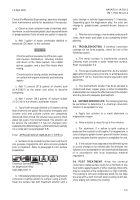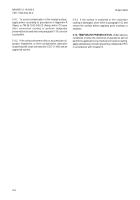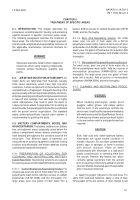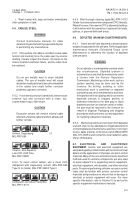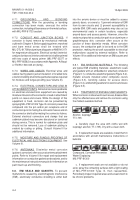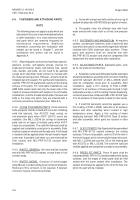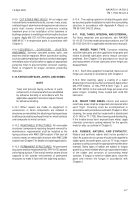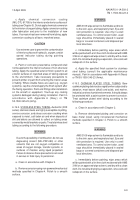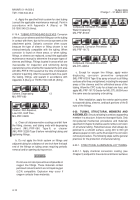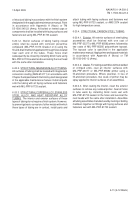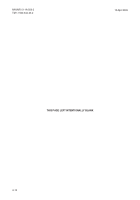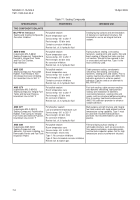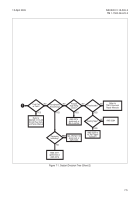TM-1-1500-344-23-2 - Page 112 of 240
6-8
NAVAIR 01-1A-509-2
TM 1-1500-344-23-2
15 April 2009
Compound, Corrosion Preventive
4
Water Displacing
MIL-PRF-81309
Compound, Corrosion Preventive
6
MIL-PRF-16173
6-15. SPRINGS.
Springs which are so tightly coiled
that the areas between the coils cannot be plated or
painted for corrosion protection shall be coated with
water displacing corrosion preventive compound
(MIL-PRF-81309 Type II) by spraying or dipping, and
allowed to dry for at least one hour. After drying, apply
a coating of MIL-PRF-16173 Grade 4 to the springs by
spraying or dipping. These requirements do not apply to
springs operating in oil or hydraulic fluids.
6-16. SURFACES AND COMPONENTS EXPOSED
TO EXHAUST GASES, GUN GASES, AND ROCKET
BLAST
. Residues from exhaust gases, gun gases, and
rocket blast are very corrosive and can cause
deterioration of paint systems. Frequent cleaning of
these areas to remove residue is required and shall be
accomplished in accordance with Chapter 2.
6-17.
TANKS, POTABLE WATER.
The interior
surfaces of aluminum alloy potable water tanks shall not
be painted or conversion coated. Remove corrosion by
using the mechanical methods outlined in Chapter 4.
Flush thoroughly with clean fresh water and ensure all
debris is removed.
6-18. THIN METAL (0.0625 INCH THICKNESS AND
LESS).
6-18.1. Severe pitting, intergranular, and exfoliation
corrosion on thin metal requires removal by mechanical
methods specified in Chapter 4 as appropriate for the
type of metal involved. Use extreme care and consult
the applicable maintenance manual for structural
damage limits when removing corrosion from thin metal.
When stains, surface corrosion, and mild to moderate
pitting are found on thin structural skins (i.e., aircraft and
missile skins), chemical methods, as appropriate to the
type metal involved, are authorized for Army personnel
(see Appendix B). Chemical methods are not authorized
for Navy use. A convenient and effective mechanical
method for the removal of minor corrosion or stains on
all metals is as follows:
CAUTION
Do not allow metallic or corrosion particles to
build up around the polishing area or polishing
tool (cloth or grit paper) during the polishing
operation. Damage to thin metal may result.
a. Mix ground pumice abrasive (SS-P-821) with
clean tap water to form a paste. Using a clean, soft cloth
(such as cheesecloth, CCC-C-440), apply the paste to
the area being treated and abrade the area with a light
rubbing motion.
b. When pumice has dried to a white powder, wipe
off with a clean, dry, soft cloth. If corrosion products
(observed as stubborn stains) still exist, use number
600 grit wet or dry abrasive paper and water to remove
the remaining corrosion. Wipe clean with a clean, soft,
dry cloth.
c. Refer to Chapter 5 for the required surface
treatment, and paint in accordance with Appendix A
(Navy) or TM 55-1500-345-23 (Army).
6-19.
TUBING, NON-STRUCTURAL MEMBERS
AND ASSEMBLIES
.
Non-structural tubing is tubing
that transfers a functional fluid (e.g. oxygen, hydraulic
fluid, engine oil). Use the same procedures and materials
specified for corrosion removal on structural tubing
members and assemblies specified in paragraph 6-20.
6-19.1. ALUMINUM TUBING.
WARNING
Due to the possibility of combustion, do not use
degreasing solvent (MIL-PRF-680) or other
solvents that are not oxygen compatible on
areas of oxygen storage, transfer systems, or
surfaces of missiles using liquid propellant.
Failure to observe these precautions can result
in serious or fatal injury to personnel.
6-19.1.1. Treat aluminum tubing according to the
following procedure.
a. Clean in accordance with Chapter 2.
b. Remove corrosion using non-powered mechanical
methods specified in Chapter 4. Polish to a smooth
surface.
Back to Top


